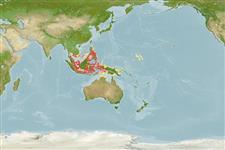Gastropoda |
Lepetellida |
Haliotidae
Environment: milieu / climate zone / গভীরতার পরিসীমা / distribution range
বাস্তুসংস্থান
. Tropical
Western Central Pacific: from Philippines to southern Indonesia.
Length at first maturity / আকৃতি / Weight / Age
পরিপক্কতা : Lm ? range ? - ? cm Max length : 5.0 cm ShH পুরুষ/ লিঙ্গ অনিধর্ারিত ; (সূত্র 349); common length : 4.0 cm SHL পুরুষ/ লিঙ্গ অনিধর্ারিত ; (সূত্র 349)
The shell is ovate, with a low, non-protuding spire. Outer surafce smooth, with holes slighly raised from the shell surface, the last 5 or 6 holes open. Regularly convex outer lip of the shell. Colouration: outside shell greenish brown, with cream or whitish streaks and blotches; inside shell shiny, iridescent (Ref. 128042).
Found in coral reef (Ref. 128042) and shallow subtidal areas (Ref. 349, 128042), particularly rocky intertidal shores (Ref. 128042).
Life cycle and mating behavior
পরিপক্কতা | প্রজনন | ডিম ছাড়া | Eggs | ডিম্বধারন ক্ষমতা | Larvae
Members of the order Patellogastropoda are mostly gonochoric and broadcast spawners. Life cycle: Embryos develop into planktonic trocophore larvae and later into juvenile veligers before becoming fully grown adults.
Poutiers, J.M. 1998 Gastropods. p. 363-648. In Carpenter, K. E. and V. H. Niem. 1998. FAO species identification guide for fishery purposes. The living marine resources of the Western Central Pacific. Volume 1. Seaweeds, corals, bivalves, and gastropods. Rome, FAO. (সূত্র 349)
IUCN Red List Status
(সূত্র 130435: Version 2025-1)
CITES status (সূত্র 108899)
Not Evaluated
Not Evaluated
Threat to humans
Harmless
Human uses
মৎস্য: বাণিজ্যিক
| FishSource |
হাতিয়ার
আরো তথ্য
ট্রফিক বাস্তুতন্ত্র Food items (preys)
পথ্য উপাদান
খাদ্য গ্রহণ
শিকারী প্রাণী সমূহ
Population dynamicsবৃদ্ধিMax. ages / sizesLength-weight rel.Length-length rel.Length-frequenciesMass conversionপ্রাচুর্য Life cycleপ্রজনন পরিপক্কতা ডিম্বধারন ক্ষমতা ডিম ছাড়া EggsEgg developmentLarvae Physiologyঅম্লজান ব্যবহার
Human RelatedStamps, coins, misc.
ইন্টারনেট সুত্র
Estimates based on models
Fishing Vulnerability
Low vulnerability (10 of 100).
